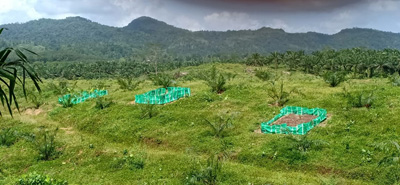Turmeric under oil palm
Turmeric (Curcuma domestica) in the botanical family of Zingiberaceae has been used in India for more than 5000 years now. Initially, it was cultivated for dye as its vivid yellow colour works brilliantly as a colouring agent. Then its highly developed uses came to be known and people started using it for cosmetic and beautification purposes and eventually as a medicine. Later it became popular as a spice. Originating in India, turmeric had reached China by 700 A.D., East Africa by 800 A.D. and West Africa by 1200 A.D. Then it had begun to become popular all over the world. It is known that the Arab traders had carried turmeric with them to Europe in the 13th century.

Turmeric being grown in an oil palm plantation
Turmeric is available in the market as in a whole dried form or in a powdered form. It is also used as an ingredient in the preparation of curry mixtures. Oils and oleoresins are extracted from turmeric which is mainly used as a colouring and flavouring agent in the food industry. It is also used as a colouring in textiles and preparation of specific paints. In Ayurvedic and Chinese medicine turmeric is a common ingredient. In India turmeric is largely used as a disinfectant in day-to-day life and in religious ceremonies.
Though there are a number of locally grown varieties they are not specially identified. There are imported varieties namely, Gunter, Puna and Madurasi Majal and they have been mixed with local varieties.
After the COVID-19 pandemic growing Turmeric is a lucrative way of earning money, especially with the present government’s policy decision to stop importation of Turmeric to the country. Also the crop does not need much technology and therefore it could be done at a domestic level too. In order to improve the unit land productivity this crop will be a better option under coconut and oil palm plantations. Growing Turmeric in coconut plantations is a well-known practice and it is not yet practiced under oil palm plantations in Sri Lanka.
At present oil palm plantations in Sri Lanka are mainly managed by Regional Plantation Companies. Nevertheless oil palm cultivation is not popular among the small holder sector. During first three years of young oil palm fields, lot of land area is underutilised and can be effectively used under ground and above ground area to maximise the unit land productivity during immature phase. In Sri Lanka there is no designed scientific research that has been carried out for the possibility of intercropping.
To understand the profitability and applicability of Turmeric under young oil palm, a designed research trial was established in 2019 at Thalgaswella estate of Elpitiya Plantations PLC a collaborative research with the faculty of Agriculture, University of Ruhuna, Mapalana, Kamburupitiya. The main objective of the research was to study the possibility of intercrop under immature oil palm cultivation in Sri Lanka.
During the experiment many soil types were tested. However well-drained sandy clay loam soils rich with organic matter and sandy loam are the most suitable soil types. Poorly drained rocky or clay type soils are not suitable. Soil pH should be in the range of 5.5 – 6.5.
Fertiliser recommendation
Fertiliser is applied after weeding and properly mixed with the soil. Thereafter beds should be mulched with suitable material. Fertiliser is applied with the onset of rain or should be irrigated after fertiliser application. In addition, Gliricidia leaves can be added as an organic fertiliser and thereby can cut down the chemical fertiliser as well as to protect the soil moisture.
Encouraging results showed at the first harvesting of Turmeric in January 2020. Initial planting material of Turmeric was 2.280 kg and final harvest recorded as 19.5 kg (on an average one trial plot has given 6.5 kg of yield out of three plots) which is almost 1: 09 ratio. In other words it has given 3720 kg of green Turmeric yield per hectare. The initial planting material cost was Rs. 228 (price of one kg was Rs.100). This means if we grow Turmeric with oil palm in its early stages we can easily earn Rs. 297,372 per hectare (selling price is @ Rs. 80 per kg). This is purely by utilising the open space of oil palm plantation during its juvenile period.
This trial is continuing and so far the results have proven that there is no evidence whatsoever of showing ground water depletion due to oil palm. During the past drought period all three intercrops withstand firmly along with surrounding oil palm trees. Therefore this is clear eye opener to the plantation companies those who are growing oil palm to maximise the unit land productivity and anchor the national economy by growing Turmeric within their plantations.
Also there are a few constraints which could be identified in this intercropping activity. They are; drought, lack of funds, price instability, lack of technical know-how, problems of finding enough labour and quality planting materials and thefts.
Notwithstanding the above mentioned constraints the system has great scope for expansion within oil palm plantations in Sri Lanka. In principle, this is a sustainable system provided necessary inputs are available in proper times and quantities and the system is managed appropriately. At present only Elpitiya and Watawala plantation companies have embarked on this intercropping practice with Turmeric and Ginger under oil palm.
(This article is based on research conducted by Ruhuna University and Elpitiya Plantations PLC)


